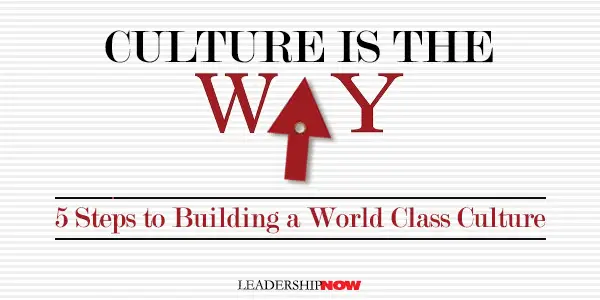 |
 |
03.20.23

Culture is the Way: 5 Steps to Building a World-Class Culture
YOU CAN CHANGE the results your organization is getting by changing its culture. And every organization has a culture whether it is by design or by default. “Whether an organization has a world-class culture or a toxic one, its future depends on how much attention and focus it puts on growing its culture,” writes Matt Mayberry, the author of Culture is the Way: How Leaders at Every Level Build an Organization for Speed, Impact, and Excellence. Culture serves as the internal compass for an organization’s fundamental beliefs, how the organization behaves daily, and its level of market performance. To begin, let’s look at the five most common roadblocks that stop us in our pursuit of cultural excellence that Mayberry addresses: 1. Lukewarm leadership buy-in. “Most senior leadership teams consist of accomplished leaders with a wealth of experience, and the last thing the majority of them will want to do is shift their leadership style or change how they have done things for the past ten to twenty years.” 2. All slogans and no action. “Words don’t build culture or change culture by themselves. It takes action. Culture is not about turning values into behaviors. It’s about turning values into repeatable behaviors, into actions that become daily habits that are shared across the organization.” 3. Temptation of instant gratification. “When we have a strong desire for something, our patience is severely tested. Any goal worth achieving, whether it’s a personal goal, a professional aspiration, or building a great workplace culture, requires a delicate balance of tenacity and extraordinary patience.” 4. Distortion and distraction. Just throwing ideas around and seeing what sticks and what doesn’t isn’t going to get you any closer to a solution, and it could actually do more harm than good. You must use caution when rushing to adopt and implement an idea that you read about.” 5. Lack of cascading change. There is no end date. It is an ongoing commitment. “Being interested is not the same as action taken. Being interested in creating a great culture is exactly that. Interest. It will never progress unless consistent action is taken.”
Here is an overview of his five-step process: Step One: Define Your Culture You must be ruthlessly clear about who you are as an organization. The culture has to be clearly defined so that everyone knows what you mean when we say, “our culture is.” Everyone must see the culture in the same way. “Great cultures are defined cultures. This means that every leader, manager, and employee can describe the culture and what it stands for, and the descriptions will be very similar to a large extent.” Step Two: Discovery Through Collaboration and Inspiration “Changing culture begins with changing one person’s mindset and behavior at a time. And changing mindsets and behaviors, especially at scale, necessitates making people feel like they are a vital part of the process rather than relying on old engagement methods.” Take a bottom-up approach. “Culture needs to be top-down directed but then bottom-up created.” Step Three: Launch, Cascade, and Embed If you want to drive culture change, you need a playbook. That playbook should ensure management team alignment, have an official launch date, a communication strategy, a plan to cascade the message throughout the organization, create a behavioral manifesto, and a plan for feedback. “You must convey a moving and compelling message that sends shockwaves throughout the company.” Step Four: Drive Long-Term Impact Creating a sustainable culture “demands unwavering fanaticism to the ongoing process and journey.” Building a culture requires consistent focus for the long term. Mayberry’s Five-Step Fanatical Framework helps you do just that. It entails continuous fanatical attention, development, and nurturing, fanatical focus on the vital areas of improvement, fanatical about alignment, fanatical about follow-through, and fanatical about the why. Step Five: Leaders Must Blaze the Trail How well the organization’s leaders practice what they preach will determine the long-term success of the desired culture. Nothing makes up for poor leadership. Leaders should coach for excellence. “The best leaders who get the most out of their teams identify as coaches rather than managers or leaders.” 
Posted by Michael McKinney at 07:59 AM
|
BUILD YOUR KNOWLEDGE
 

How to Do Your Start-Up Right STRAIGHT TALK FOR START-UPS 
Grow Your Leadership Skills NEW AND UPCOMING LEADERSHIP BOOKS 
Leadership Minute BITE-SIZE CONCEPTS YOU CAN CHEW ON 
Classic Leadership Books BOOKS TO READ BEFORE YOU LEAD |